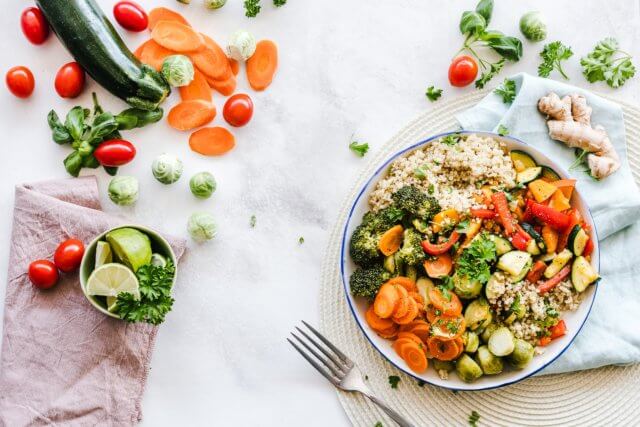
Hello! Long time no see my friends…oh how I have missed you!
I wanted to share with you an article I wrote for Driven Performance Training, for National Nutrition Month. My husband asked me to write a little something about THE most common question we get in regard to diet and nutrition…which is the best diet. But when Andy asked me to write an article, he knows my long-winded nature and my love for poetic commentary, he was pretty clear that he wanted “Just the Facts, Ma’am.” So that’s what I gave him here, JLFM. Don’t get me wrong 👇this thing is a beast of an article but I stuck to the facts of each diet, giving pros and cons and who would benefit from it. I hope to break out the finer points in future articles, so look out for those, but for now, grab your favorite beverage and find a nice little nook and enjoy the read!
What to eat, what not to eat: that is the question! Being “healthy” and eating a “healthy” diet is very confusing today. Every article you read states their diet is the best. They have studies that back up their claims, often contradicting the last article you read. The truth is though, nutritional science is still in its infancy because the research (especially on how diet impacts long term health) is difficult to do well. Most of the studies rely heavily on observational epidemiology, which is able to identify “associations,” yet not the exact cause and effect. This often leads to more questions that can only really be answered with randomized controlled trials, which are difficult to perform.
In spite of these limitations, the research can still give us valuable insight into what a healthy diet might look like for you. Before we get started though, I just want to give the reminder that everyone is different. Everyone’s optimal diet is going to be different. There is no good or bad food ( for the most part), and it really comes down to your health goals and your preferences to help you decide what is best for you.
SAD: Standard American Diet
The Standard American Diet (SAD for short) is also known as the Standard Western diet. It consists of a high intake of red meat; processed meats; prepackaged, processed and manufactured foods; fried foods; high-fat dairy; refined grains; high sugar, and lots of high fructose corn syrup products.
Pros:
- Taste, shelf life, and convenience – food are meticulously manufactured to perfectly hit all our taste receptors for optimal “deliciousness”, which increases our desire for them.
The beautiful rainbow of colors they are able to achieve with the synthetic dyes is pretty incredible. I mean blue yogurt comes in a plastic tube and is just so fun to squeeze into your mouth!
SAD food is super solid and durable. Shelf life is paramount when creating these foods so they can hang out in your pantry for years on end!
Cons:
Obviously, I’m kidding. The SAD is well, just SAD. I know this isn’t really a diet people choose. Rather, it’s just the default that we as a society have adopted out of convenience. But we all know this diet wreaks havoc on our metabolism, endocrine system and overall health. And since this is a default diet, it can be easily improved upon with some small intentional changes, so keep reading to find out more!
Keto or Ketogenic
What it is:
The Keto or Ketogenic Diet is a high-fat, adequate-protein, low-carbohydrate diet that was developed to treat difficult-to-control (refractory) epilepsy in children. In this diet, you have a very low (less than 50g/day) carbohydrate intake, which forces the body to stop using glucose (carbs) as your primary energy source. Instead, your body begins burning/using fat (both dietary and bodily) as your primary energy source. When glucose is depleted in the body, the only fuel source is fat. Ketones are produced to be used by the cells, and when this happens we go into Ketosis. Here’s the general daily caloric breakdown: 70-80% fat, 10-20% protein, and 5-10% carbohydrate. For a 2000-calorie diet, this translates to about 165 grams fat, 75 grams protein, and 40 grams carbohydrate.
Pros:
- Potential for significant weight and fat loss in the short term and with this weight loss have some improvement in some metabolic syndromes like in insulin resistance.
Severely limits “bad” carbs and a lot of the really problematic SAD foods like candy, soda cookies, chips…most of the processed refined white flour based sugary foods and beverages.
Some research that suggests there are some anticancer benefits of a Ketogenic diet, this mainly stems from the very limited sugar and simple carbohydrate content in this diet. Tumors and fast-growing cancers cells thrive in a high glucose environment, so glucose (blood sugar) theoretically can inhibit cancer growth. But the research is still out on this and no single food or food group prevents or causes cancer, but certainly making the environment less favorable to cancer cells is better.
Cons:
- Potential to excessively limit high-nutrient, good carbohydrate foods like fruits, vegetables, and whole grains, due to the super low carbohydrate requirement to be in ketosis. So you are missing out on the really beneficial effects of foods like apples, bananas, sweet potatoes, Brussels sprouts, spinach, beans, quinoa, oats, barley. These plant-based foods are where we get the majority of our micronutrient vitamins and minerals, as well as all of our phytochemicals and fiber. We need optimal amounts of these micronutrients for all parts of our bodies to function properly.
Limited optimal fiber intake seems to be common, as fruits, veggies, and whole grains are usually the highest sources of these. I could write a whole article on the importance of fiber in the diet, but for now, let’s just say that it’s really important. Lack of adequate fiber is a huge culprit in a lot of chronic disease conditions we see prominently in our society today.
Keto has an overwhelming focus on macronutrients (fat, protein, and carbohydrates). Any diet in which little consideration is given to the micronutrient content is a huge red flag (and a pet peeve of mine). I believe that it’s a bit short-sighted, and can unintentionally lead to low nutrient density. It’s sort of like only focusing on the stone and wood to build a house, but not considering the nails and mortar that hold it all together.
Who would KETO benefit:
Anyone who has stubborn weight; people who feel like they’re being “good”, yet still have difficulty losing weight; those who have a lot of abdominal fat. The ketogenic diet can also be a good option for kick-starting weight loss, since it does help your body to begin burning body fat as fuel. One can then transition to a less-restricted, yet moderate and sustainable diet.
Whole 30 and Paleo
What they are:
Paleo and Whole 30 are two very popular diets that I’ve combined for the purposes of this article. After all, the Whole 30 is more or less a 30 Day version of the Paleo lifestyle. They’re almost identical with just a few subtle changes, so in this section, I’ve referred to them both as Paleo. The basic premise of these diets is to go back to eating the way humans were intended to eat back during the supposed heyday of human health (i.e. the Paleolithic age). This diet promotes whole foods like meat, fish, seafood, fruit, veggies, nuts, seeds, eggs, tubers, herbs, spices, and healthy oils. It avoids modern SAD foods, along with all grains, dairy, and legumes. There’s no calorie, protein, or fat percentage to follow, just simple “eat this” and “don’t eat that” guidelines. There’s also a heavy bias towards eating lots of meat. Finally, there’s no booze during the first 30 days, but one’s free to indulge in Red Wine after that.
Pros:
- The Paleo diet promotes eating whole natural, real foods – i.e. foods that are as far away from the SAD diet as possible! I’m a fan of most of what Paleo promotes. It emphasizes eating veggies and fruit as at least half of your meal, which means a well-planned Paleo diet will be high in fiber, and fairly dense in nutrients.
Limited packaged and processed foods. Again, it focuses on eating whole, real foods which really is the best way to eat.
It advocates high vegetable and fruit intake, which boosts the micronutrient and fiber contents of one’s diet in a beneficial manner.
Cons:
- It can be heavy on the intake of meat and saturated fat. Meat can definitely be part of a healthy diet, but some research indicates that excessive meat consumption, (particularly of red and processed meat) is associated with heart disease, stroke, type 2 diabetes, obesity, certain cancers, and earlier death.
No beans. My biggest beef with Paleo (see what I did there?) is that for some reason, beans and legumes aren’t allowed. It might sound like a small thing, but some research indicates that among the healthiest, highest longevity humans, eating legumes and beans is an underlying dietary trait among various groups. This avoidance of beans in the Paleo diet doesn’t seem the most justified and raises some red flags as to how well-justified the diet is as a whole.
Who would benefit:
Anyone who wants to start eating a whole, nutrient-dense diet that includes meat products. It’s fairly easy to follow since it doesn’t take any calorie counting or percentages to calculate. Also, there are large amounts of information on the interwebs about it, and getting started can be a breeze.
Plant-Based Diets (Vegetarian and Vegan)
What it is:
The Plant-Based diet is pretty much what the name implies. It’s a diet made up of most or all plant matter, limiting or eliminating all animal products (i.e. meat and dairy). What makes this diet most interesting is that people choose to adopt this way of eating for both ideological and health reasons.
Pros:
- A plant-based diet is very micronutrient dense and has been shown to have huge positive impacts on both health and longevity. This benefit comes from the high nutrient density, anti-inflammatory effects, and high fiber content of plant foods. During my integrative health practitioner training last year, I was introduced to a concept called the Blue Zones, and have been fascinated ever since. Essentially, the blue zones are the 5 places around the world with the longest living, healthiest people on the planet. There are 9 Commonalities among these groups, with diet being a major factor. Most of them are mainly plant-based, with little to no meat intake.
Plant-based eaters have a lower incidence of heart disease, cancer, and diabetes; i.e. the 3 biggest causes of morbidity and mortality in the modern world. Also, studies show people who eat a plant-based diet generally have a lower BMI than meat-eaters. The plant-based diet has also proven beneficial in the lifestyle management of diabetes, arthritis, heart disease, autoimmune diseases, and cancer (both treatment and prevention).
Positive Environmental impact. Growing, feeding, watering and transporting animals or animal products requires many resources, as well as a higher carbon footprint than plant agriculture. Limiting the intake of these products can be beneficial for minimizing humans’ overall environmental footprint.
Cons:
- GI Discomfort – Beans, Beans the musical fruit…such are some of the biggest complaints when starting a planted based diet. GI issues are often associated with the big increase in the fibrous material of a plant-based diet. SADly, our gastrointestinal tracts just aren’t accustomed to eating such a high amount of plant fiber and matter which can initially cause gas, discomfort and bloating. But, eventually, GI bacteria begins to grow and flourish as your body adjusts to the new diet.
No meat. Many people are very accustomed to and enjoy eating lots of meat, so this change may be unpleasant for many. Depending on your food preference and personality, a gradual or hybrid approach to this diet would be preferable.
Extra planning is required to make sure you’re meeting the daily requirements of protein, b12, iron, and zinc. Like most dietary changes, this one requires additional planning to ensure all the essential micronutrients are adequately consumed.
Who would benefit:
This is a great option for anyone who wants a whole food, nutrient-dense diet. You don’t have to go full vegan to realize the positive effects of a plant-based diet. One can simply choose to eat predominantly plant-based, consuming meat and other animal products on occasion. And, since plant-based eating is fairly popular, so there are ample resources online.
Main Take Away:
Biggest takeaway…SAD is bad, but all of the other diets (Keto, Paleo, Plant Based) have their unique benefits and drawbacks. You’ll need to decide which diet is best for you based on your unique health goals. All it takes is a little thought and planning to develop a diet to help you meet your goals. Resources are plentiful on the internet, and enlisting the help of a professional is also just a click away. Regardless, taking small or large steps away from the typical western diet and towards a whole food, real food diet will have positive effects on your health.
Good luck, and be sure to reach out with any and all questions!
Be well,
Sally
P.S. You DID IT! If you are still reading this after over 2000 works, you are a Rock Star and I appreciate your commitment! XO, see you again real soon!
Resources
https://www.hsph.harvard.edu/nutritionsource/healthy-weight/diet-reviews/ketogenic-diet/




